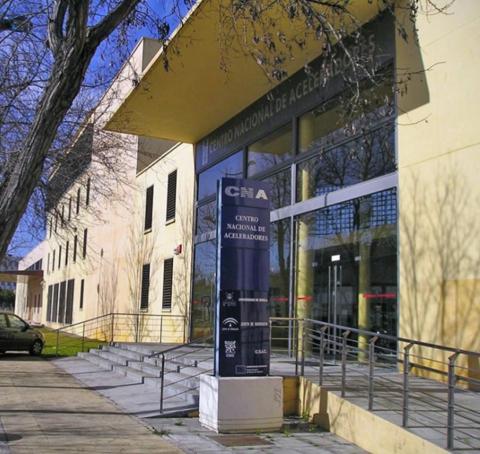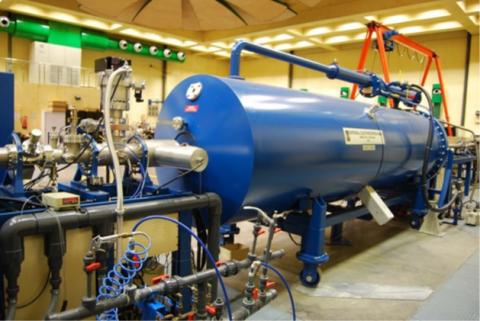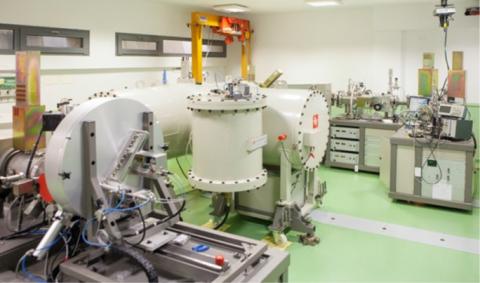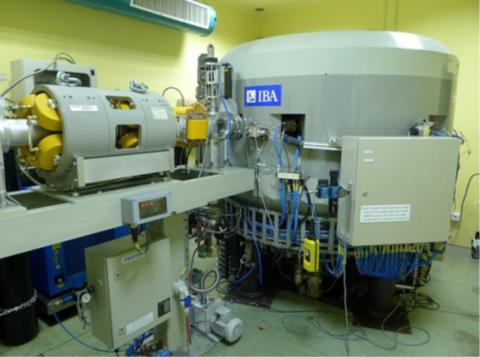




General information
-
Hosting OrganisationCentro Nacional de Aceleradores
-
Addressc/ Thomas Alva Edison 7, Sevilla, 41008
-
Contact Info:
-
Phone
-
Emailcna@us.es
Description
The Centro Nacional de Aceleradores (CNA) is a joint research center of the University of Seville, the regional government of Andalucía and the Spanish National Research Council CSIC. It is recognized by the Spanish government as a one of the two nodes of the Singular Scientific-Technical Facility IABA (Insfraestructura de Aplicaciones Basadas en Aceleradores = Accelerator Based Applications Infrastructure), dedicated to interdisciplinary research in the particle accelerator area and open to external users.
Main equipment or Facilities
CNA has six major facilities: a Van de Graaff 3 MV Tandem accelerator, a 18/9 MeV Cyclotron accelerator, an Accelerator 1MV Mass Spectrometer, a PET / CT scanner, a radiocarbon dating system called MiCaDaS and a 60Co Irradiator. The application of these six infrastructures covers fields as diverse as material sciences, environmental impact, nuclear and particle physics, nuclear instrumentation, medical imaging, biomedical research and preclinical molecular imaging, 14C dating and irradiation in samples of technological and biological interest, among others.
Projects under Development
- Accelerator Mass Spectroscopy (AMS) development: establishment of methodology for CI-36, Ca-41, consolidation of techniques for U-234. U-235, U-236, U-238, NP-237, AM-243 and measurement development for C-14 in liquids (3788/0223)
- Dosimetry monitor FLASH therapy (HR23-00718)
- EUROpean Laboratories for Accelerator Based Science - EURO-LABS (4598/1176 - another researcher)
- Explotation of European nuclear physics research facilities (ASTRO21/1.3/3)
- Neutron physics, nuclear instrumentation and hadrontherapy developments in CNA and international facilities (PID2021-123879OB-C21)
- Shear flux impact in the transport of magnetically confined fusion plasma particles (PID2020-116822RB-I00 - research team)
- Irradiation of detectors with accelerators (ASTRO21/1.1/1)
- Neutrons, nuclear instrumentation and protontherapy-related research in CNA and international research facilities (RTI2018-098117-B-C21)
- New developments for Low Energy Accelerator Mass Spectroscopy (LEAMS) applied to new environmental challenges and nuclear waste management (PID2022-140680NB-I00)
- Recyclable Materials Development at Analytical Research Infrastructures (ReMade-at-ARI) (GRANT AGREEMENT NO. 101058414)
- Recyclable Materials Development at Analytical Research Infrastructures (ReMade-at-ARI) (GRANT AGREEMENT NO. 101058414)
- Supplying Accurate Nuclear Data for energy and non-energy Applications - SANDA (H2020-847552)
- Towards ultra-high dose rates in proton therapy: an ionoacoustic approach for in vivo dose monitoring - RAPID (101146938)
- WPSA: Preparation and Exploitation of JT-60SA (CFP-IPH-AWP19-SA-05-CIEMAT-01)
Technology Capabilities
1. Nuclear physics beam line This line includes a high-volume vacuum chamber, where nuclear instrumentation (detectors, electronics, etc.) that will be used in international Nuclear Physics facilities, can be developed and tested.
2. Microbeam chamber Manufactured by Oxford Microbeam Ltd., in this line it is possible to focus the beam down to size of a few microns using a magnetic quadrupole triplet. The scanning system, synchronized with the data acquisition, allows the formation of maps from different signals with a maximum size of a few mm2. One of our main research lines is the analysis by PIXE and RBS of the actinide elemental distribution in microscopic particles originating from the hydrogen bombs involved in several nuclear accidents, where the results are similar to those obtained by confocal X-Ray fluorescence (XRF) in a synchrotron facility.
3. Multipurpose IBA chamber This chamber is equipped with a set of particle, gamma and X-Ray detectors and a large target holder to carry out simultaneously different IBA experiments (RBS, PIXE, NRA and PIGE). In this chamber, we have recently investigated the use of novel solid 4He targets for experimental studies on nuclear reactions, the composition of solid-state hole conductor in solar cells prepared by vacuum processing and a novel ionizing particle detector based on thin films multilayers.
4. Ionoluminescence chamber Located behind the multipurpose chamber, this vacuum chamber has black coating walls and is equipped with a heatable sample holder up to 500 °C and a photonic diagnostic system that allows mainly ionoluminescence studies. The first application of the chamber has been the characterization of different scintillator materials used for fast-ion loss detectors in nuclear fusion reactors.
5. Irradiation chamber This beamline has been designed to allow the irradiation of large areas (up to 16×20 cm2) by raster scanning of the beam through magnetic deflection. It is mainly used by companies and research centers to perform irradiation tests of electronic devices and to test radiation detectors.
6. Channeling chamber Manufactured by Charles–Evans, this line is dedicated to channeling analysis of single crystalline samples using a 4-axis goniometer. A parallel beam is obtained with a telescopic system formed by two sets of slits. The chamber is equipped with particle, X-Ray and γ -Ray detectors. Through experiments in the implantation and channeling beamlines, we have recently studied the formation of magnetic SiC substrates for spintronic applications.
7. External beam This line is mainly used for cultural heritage studies, since the use of in-air ion beam techniques (in combination with a good lateral resolution) presents numerous advantages for the analysis of inhomogeneous objects. The use of some elements purchased from Oxford Microbeams, like a magnetic quadrupole doublet, a precision four jaw object slit and an exit nozzle set with micrometer adjustment, allow to obtain a spatial resolution of about 60 μm. Recent applications include the study of the manufacturing of gold jewels of the Carambolo treasure and of gold electroplating techniques on silver substrates.
8. HiSPANoS line HiSPANoS, from Hispalis Neutron Source, is the first accelerator based neutron source in Spain. At HiSPANoS, neutrons are produced in a high-energy range covering from thermal to fast neutrons up to 9 MeV through the reactions p(7Li, n), d(7Li, n), d(D, n), p(9Be, n) and d(9Be, n). The main research application of the new neutron source is related to astrophysics, medical physics, detector characterization, electrical devices irradiation for aerospace purposes and neutron radiography, among others. In 2018, a buncher and chopper system and a new experimental line dedicated to neutron time of flight (TOF) measurements were installed. The pulsing system was designed to produce protons and deuterons pulsed beams with a pulse width of 1–2 ns at the target position at a frequency that can be varied from 32.5 kHz to 2 MHz.
Summary of Research Services
Ion Beam Analysis (IBA) technique measurements
Actinide and Iodium-129 measurements with Accelerator Mass Spectroscopy (AMS)
Radiocarbon dating
Radiopharmacy and medical imaging
Photon irradiation
Basic nuclear physics
Neutron beams
Radiation detectors development
Procurement process
Access to the CNA's facilities is open to the scientific community and to national and international society. This access is articulated through open periods for applications (four per year). Any request submitted to the service must be duly justified and sent to the scientific committee, which evaluates the scientific quality of the proposal. Once accepted, a specialist technician from the CNA is assigned and the date of the proposed experiment is coordinated with the rest of the planned measures. The CNA has a series of official tariffs that apply to all users and that are aimed at contributing to the basic expenses that occur in the activities. These rates are published on the internet (http://institucionales.us.es/solicitudescna/index.php/es/). The admissions are managed by the University of Seville and are made available to the centre.